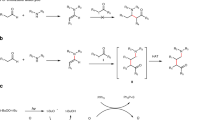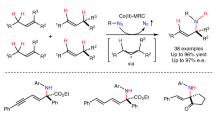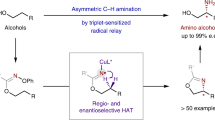Abstract
The role of alcohol in the Yb(OTf)3- and Y(OTf)3-catalyzed stereoselective radical polymerization of acrylamides is clarified. The coordination of an alcohol to the metal triflate generates a new complex, which increases both the polymerization rate and stereocontrol compared to those achieved by the metal triflate without an alcohol in the polymerization of N,N-diethylacrylamide. While the lanthanide triflate-catalyzed stereoselective polymerization of acrylamides in MeOH has already been well established synthetically, this is the first example that proves the formation of an alcohol-coordinated catalyst as the active catalyst. Job’s plot suggests that the stoichiometry between Yb(OTf)3 and MeOH in the complex is 1:2. The polymerization rate decreases slightly when MeOD is used instead of MeOH, with a secondary isotope effect of 1.14, strongly suggesting the importance of hydroxyl groups for increasing the reactivity. In contrast, no apparent secondary isotope effect is observed to affect the stereoselectivity. The chirality of the alcohol ligand does not affect the stereoselectivity, illustrating that the stereochemistry is most likely controlled by the penultimate effect, which has already been proposed. Furthermore, the conditions are highly compatible with those for organotellurium-mediated radical polymerization, and the dual control of molecular weight and tacticity is successfully achieved.
This is a preview of subscription content, access via your institution
Access options
Subscribe to this journal
Receive 12 print issues and online access
$259.00 per year
only $21.58 per issue
Buy this article
- Purchase on Springer Link
- Instant access to full article PDF
Prices may be subject to local taxes which are calculated during checkout






Similar content being viewed by others
References
Berrisford DJ, Bolm C, Sharpless KB. Ligand-accelerated catalysis. Angew Chem. 1995;34:1059–70.
Katsuki T, Sharpless KB. The first practical method for asymmetric epoxidation. J Am Chem Soc. 1980;102:5974–6.
Hentges SG, Sharpless KB. Asymmetric induction in the reaction of osmium tetroxide with olefins. J Am Chem Soc. 1980;102:4263–5.
Kitamura M, Okada S, Suga S, Noyori R. Enantioselective addition of dialkylzincs to aldehydes promoted by chiral amino alcohols. Mechanism and nonlinear effect. J Am Chem Soc. 1989;111:4028–36.
Lee S, Hartwig JF. Improved catalysts for the palladium-catalyzed synthesis of oxindoles by amide α-arylation. Rate acceleration, use of Aryl chloride substrates, and a new carbene ligand for asymmetric transformations. J Org Chem. 2001;66:3402–15.
Glueck DS. Catalytic asymmetric synthesis of chiral phosphanes. Chem Eur J. 2008;14:7108–17.
Chen G, Gong W, Zhuang Z, Andrä MS, Chen Y, Hong X, et al. Ligand-accelerated enantioselective methylene C(sp3)–H bond activation. Science. 2016;353:1023–7.
Saint-Denis TG, Zhu R, Chen G, Wu Q, Yu J. Enantioselective C(sp3)‒H bond activation by chiral transition metal catalysts. Science. 2018;359:4798. https://doi.org/10.1126/science.aao4798.
Van Krevelen DW, Te Nijenhuis K. Properties of polymers. Oxford: Elsevier; 2009.
Nakano T, Mori M, Okamoto Y. Stereospecific radical polymerization of 1-phenyldibenzosuberyl methacrylate affording a highly isotactic polymer. Macromolecules. 1993;26:867–8.
Hoshikawa N, Hotta Y, Okamoto Y. Stereospecific radical polymerization of N-triphenylmethylmethacrylamides leading to highly isotactic helical polymers. J Am Chem Soc. 2003;125:12380–1.
Porter NA, Allen TR, Breyer RA. Chiral auxiliary control of tacticity in free radical polymerization. J Am Chem Soc. 1992;114:7676–83.
Mero CL, Porter NA. Free-radical polymerization and copolymerization of acrylimides: homopolymers of oxazolidinone acrylimide and control of 1,5-stereochemistry in copolymers derived from isobutylene and an oxazolidinone acrylimide. J Org Chem. 2000;65:775–81.
Fujita T, Yamago S. Lewis-acid-mediated stereospecific radical polymerization of acrylimides bearing chiral oxazolidinones. Chem Eur J. 2015;21:18547–50.
Isobe Y, Fujioka D, Habaue S, Okamoto Y. Efficient lewis acid-catalyzed stereocontrolled radical polymerization of acrylamides. J Am Chem Soc. 2001;123:7180–1.
Suito Y, Isobe Y, Habaue S, Okamoto Y. Isotactic-specific radical polymerization of methacrylamides in the presence of Lewis acids. J Polym Sci Part A Polym Chem. 2002;40:2496–500.
Habaue S, Isobe Y, Okamoto Y. Stereocontrolled radical polymerization of acrylamides and methacrylamides using Lewis acids. Tetrahedron. 2002;58:8205–9.
Isobe Y, Yamada K, Nakano T, Okamoto Y. Stereospecific free-radical polymerization of methacrylates using fluoroalcohols as solvents. Macromolecules. 1999;32:5979–81.
Isobe Y, Yamada K, Nakano T, Okamoto Y. Stereocontrol in the free-radical polymerization of methacrylates with fluoroalcohols. J Polym Sci Part A Polym Chem. 2000;38:4693–703.
Yamada K, Nakano T, Okamoto Y. Stereospecific free radical polymerization of vinyl esters using fluoroalcohols as solvents. Macromolecules. 1998;31:7598–605.
Moad G, Solomon DH. The chemistry of radical polymerization. 2nd ed. Oxford: Elsevier Science; 2006.
Yamago S. Precision polymer synthesis by degenerative transfer controlled/living radical polymerization using organotellurium, organostibine, and organobismuthine chain-transfer agents. Chem Rev. 2009;109:5051–68.
Yamago S, Iida K, Yoshida J. Tailored synthesis of structurally defined polymers by organotellurium-mediated living radical polymerization (TERP): synthesis of poly(meth)acrylate derivatives and their di- and triblock copolymers. J Am Chem Soc. 2002;124:13666–7.
Imamura Y, Fujita T, Kobayashi Y, Yamago S. Tacticity, molecular weight, and temporal control by lanthanide triflate-catalyzed stereoselective radical polymerization of acrylamides with an organotellurium chain transfer agent. Polym Chem. 2020. https://doi.org/10.1039/D0PY01280G.
Yamago S. Photoactivation of organotellurium compounds in precision polymer synthesis: controlled radical polymerization and radical coupling reactions. Bull Chem Soc Jpn. 2020;93:287–98.
Okamoto Y, Habaue S, Isobe Y. Lewis acid-catalyzed tacticity control during radical polymerization of (meth)acrylamides. ACS Symp Ser. 2003;854:59–71.
Satoh K, Kamigaito M. Stereospecific living radical polymerization: dual control of chain length and tacticity for precision polymer synthesis. Chem Rev. 2009;109:5120–56.
Lutz JF, Neugebauer D, Matyjaszewski K. Stereoblock copolymers and tacticity control in controlled/living radical polymerization. J Am Chem Soc. 2003;125:6986–93.
Shanmugam S, Boyer C. Stereo-, temporal and chemical control through photoactivation of living radical polymerization: synthesis of block and gradient copolymers. J Am Chem Soc. 2015;137:9988–99.
Ray B, Isobe Y, Morioka K, Habaue S, Okamoto Y, Kamigaito M, et al. Synthesis of isotactic poly(N-isopropylacrylamide) by RAFT polymerization in the presence of Lewis acid. Macromolecules. 2003;36:543–5.
Ray B, Isobe Y, Matsumoto K, Habaue S, Okamoto Y, Kamigaito M, et al. RAFT polymerization of N-isopropylacrylamide in the absence and presence of Y(OTf)3: simultaneous control of molecular weight and tacticity. Macromolecules. 2004;37:1702–10.
Ray B, Okamoto Y, Kamigaito M, Sawamoto M, Seno K, Kanaoka S, et al. Effect of tacticity of poly(N-isopropylacrylamide) on the phase separation temperature of its aqueous solutions. Polym J. 2005;37:234–7.
Biswas CS, Patel VK, Vishwakarma NK, Tiwari VK, Maiti B, Maiti P, et al. Effects of tacticity and molecular weight of poly(N-isopropylacrylamide) on its glass transition temperature. Macromolecules. 2011;44:5822–4.
Su X, Zhao Z, Li H, Li X, Wu P, Han Z. Stereocontrol during photo-initiated controlled/living radical polymerization of acrylamide in the presence of Lewis acids. Eur Polym J. 2008;44:1849–56.
Katsumoto Y, Etoh Y, Shimoda N. Phase diagrams of stereocontrolled poly(N,N-diethylacrylamide) in water. Macromolecules. 2010;43:3120–1.
Sugiyama Y, Satoh K, Kamigaito M, Okamoto Y. Iron-catalyzed radical polymerization of acrylamides in the presence of Lewis acid for simultaneous control of molecular weight and tacticity. J Polym Sci Part A Polym Chem. 2006;44:2086–98.
Wu Z, Peng C, Fu X. Tacticity control approached by visible-light induced organocobalt-mediated radical polymerization: the synthesis of crystalline poly(N,N-dimethylacrylamide) with high isotacticity. Polym Chem. 2020;11:4387–95.
Matsumoto A, Nakamura S. Radical polymerization of methyl methacrylate in the presence of magnesium bromide as the Lewis acid. J Appl Polym Sci. 1999;74:290–6.
Acknowledgements
This work was supported by the Japan Society for the Promotion of Science (KAKENHI (16H06352) to SY).
Author information
Authors and Affiliations
Corresponding author
Ethics declarations
Conflict of interest
The authors declare that they have no conflict of interest.
Additional information
Publisher’s note Springer Nature remains neutral with regard to jurisdictional claims in published maps and institutional affiliations.
Supplementary information
Rights and permissions
About this article
Cite this article
Park, B., Imamura, Y. & Yamago, S. Stereocontrolled radical polymerization of acrylamides by ligand-accelerated catalysis. Polym J 53, 515–521 (2021). https://doi.org/10.1038/s41428-020-00444-0
Received:
Revised:
Accepted:
Published:
Issue Date:
DOI: https://doi.org/10.1038/s41428-020-00444-0
This article is cited by
-
Rare earth–cobalt bimetallic catalysis mediates stereocontrolled living radical polymerization of acrylamides
Nature Synthesis (2023)
-
Crystallization of isotactic poly(N,N-diethyl acrylamide) synthesized by ytterbium triflate/H2O-catalyzed stereoselective radical polymerization
Polymer Journal (2021)



